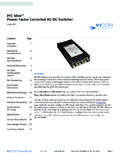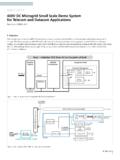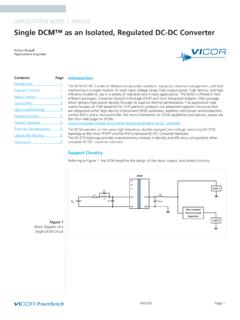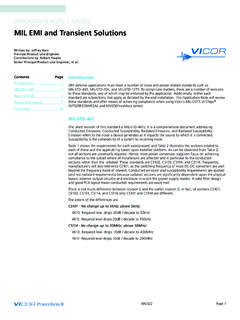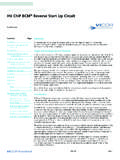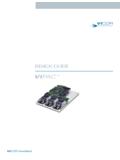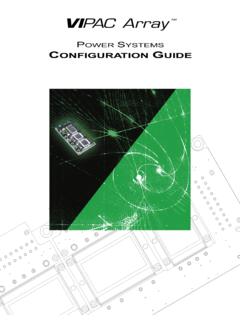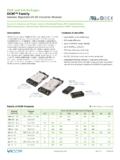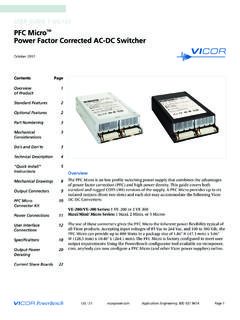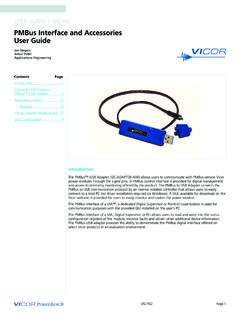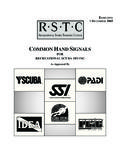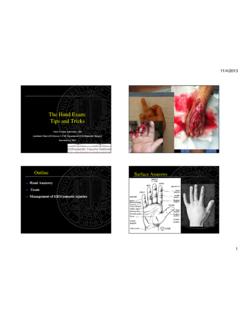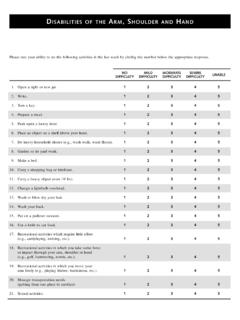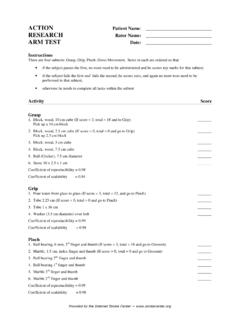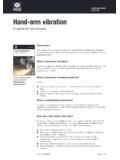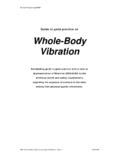Transcription of VI-ARM™ - Vicor Corporation
1 VI-ARM . VI-ARMx1xx Actual size: VI-ARMBx2xx x x S. 57,9 x 36,8 x 12,7mm C US C NRTL US. Autoranging Rectifier Modules Up to 1500 Watts Features & Benefits Absolute Maximum Ratings RoHS Compliant Parameter Rating Unit Notes (with F or G pin option) 264 VAC L to N. Autoranging input 280 VAC 100ms Microprocessor controlled +OUT to OUT 400 VDC VI-ARM-C1: B OK to OUT 16 VDC 500W @ 90 132 VAC EN to OUT 16 VDC 750W @ 180 264 VAC Output power VI-ARMB-C2: VI-ARM 500/750 Watts 115/230V. 115/230V. 750W @ 115 VAC VI-ARMB 750/1500 Watts 1500W @ 230 VAC See page 3 for derating Mounting torque 4 6 ( ) in-lbs (N-m) 6 each, 4-40 screw 96 98% efficiency Operating temperature 40 to +100 C H-Grade 100 C baseplate (no derating). Storage temperature 55 to +125 C H-Grade cULus, cT Vus, CE Marked 500 (260) F ( C) <5sec; wave solder AC Bus OK, module enable Pin soldering temperature 750 (390) F ( C) <7sec; hand solder Inrush limiting (no external circuitry).
2 CE Marked Thermal Resistance Capacity Typical Applications: systems requiring a rugged, Parameter Min Typ Max Unit full featured interface to the AC mains in the smallest possible package. Baseplate to sink flat, greased surface C/Watt Product Highlights with thermal pad (P/N 16495) C/Watt The ARM (Autoranging Rectifier Module) Baseplate to ambient is an AC front end module which provides free convection 15 C/Watt autoranging line rectification and inrush 1000 LFM C/Watt current limiting. The ARM is available in either Thermal capacity 48 Watt-sec/ C. 500/750W or 750/1500W models in a quarter brick package measuring only x x . Part Numbering The ARM interfaces directly with worldwide AC mains and may be used with Vicor VI- ARM - C 1 2 3. 300V input DC-DC converters to realize an autoranging, high density, low profile VI-ARMB - C 2 1.
3 Switching power supply. The ARM includes a microcontroller that continuously monitors Product the AC line to control bridge/doubler operation. The user need only provide Product Grade Temperatures ( C) Pin Style external capacitance to satisfy system Grade Operating Storage 1 = Short Baseplate hold-up requirements. 2 = Long Blank = Slotted E = 10 to +100 40 to +125. C = 20 to +100 40 to +125 S = Short Modumate [1] 2 = Threaded Vicor Micro series packaging technology T = 40 to +100 40 to +125 N = Long Modumate [1] 3 = Through hole H = 40 to +100 55 to +125 F = Short RoHS [1]. offers flexible mounting options for various G = Long RoHS [1]. manufacturing processes. The ARM may be K = Extra Long RoHS [2]. installed as a conventional leaded device for on-board applications, in-board for [1] low profile, height restricted applications, Pin styles S, N, F & G are compatible with the ModuMate interconnect system for socketing socketed or surface mounted with optional and surface mounting [2] Not intended for socket or Surfmate mounting ModuMate interconnect products.
4 VI-ARM Rev Page 1 of 11 06/2017 800 VI-ARMx1xx Electrical Characteristics Electrical characteristics apply over the full operating range of input voltage, output load (resistive) and baseplate temperature, unless otherwise specified. All temperatures refer to the operating temperature at the center of the baseplate. Specifications apply for AC mains having up to 5% total harmonic distortion. INPUT SPECIFICATIONS. VI-ARM - 1 VI-ARMB - 2. Parameter Min Typ Max Min Typ Max Unit Notes 90 132 90 132 VAC Autoranging (doubler mode). Operating input voltage 180 264 180 264 VAC Autoranging (bridge mode). Input undervoltage 90 90 VAC No damage Input surge withstand 280 280 VAC 100ms 47 63 47 63 Hz C, E-Grade AC line frequency 47 880 47 880 Hz T & H-Grade 0 0 Amps 120 VAC. Input current, RMS. 0 0 Amps 240 VAC. Dependent on line source Power factor impedence, holdup capacitance, and load 264 VAC peak line, Inrush current 30 30 Amps cold start Holdup Capacitance 1600 2400 F.
5 OUTPUT SPECIFICATIONS. VI-ARM - 1 VI-ARMB - 2. Parameter Min Typ Max Min Typ Max Unit Notes 0 500 0 750 Watts 105 132 VAC (Fig. 1). Output power 0 750 0 1500 Watts 210 264 VAC (Fig. 2). Efficiency 120 VAC 94 96 94 96 % 240 VAC 96 98 96 98 % Output voltage 200 375 200 375 VDC 90 264 VAC. CONTROL PIN SPECIFICATIONS. Parameter Min Typ Max Unit Notes AC Bus OK (B OK) On-state resistance (low) 15 To negative output - bus normal On-state current (low) -50 mA Bus normal Off-state voltage 12 14 16 VDC Bus abnormal, 27k internal pull up to 15 VDC (Fig. 12). On-state threshold 235 240 245 VDC Output bus voltage Off-state threshold 200 205 210 VDC Output bus voltage Module Enable (EN) On-state resistance (low) 15 To negative output - converters are disabled On-state current (low) 50 mA Off-state voltage 12 14 16 VDC 150k internal pull up to 15 VDC (Fig.)
6 11). On-state threshold 235 240 245 VDC Output bus voltage Off-state threshold 185 190 195 VDC Output bus voltage Over voltage shutdown 380 390 400 VDC AC Bus OK - module enable, 12 14 16 VDC AC Bus OK and module enable thresholds track differential error*. * Tracking error between BUS OK and Enable thresholds VI-ARM Rev Page 2 of 11 06/2017 800 VI-ARMx1xx Electrical Characteristics (Cont.). SAFETY SPECIFICATIONS. Parameter Min Typ Max Unit Notes Isolation voltage (IN to OUT) None Isolation provided by DC-DC converter(s). Dielectric withstand 1,500 VRMS. (I/O to baseplate) Leakage current 100 A No filter AGENCY APPROVALS. Safety Standards Agency Markings Notes ARM1 xxx UL60950, EN60950, CSA 60950 Baseplate earthed, fast acting line fuse, cT Vus Bussman ABC10. CE Marked Low voltage directive ARM2 xxx UL60950, EN60950, CSA 60950 Baseplate earthed, fast acting line fuse, cT Vus Bussman ABC15.
7 CE Marked Low voltage directive GENERAL SPECIFICATIONS. 1520. Parameter 1500 Min Typ Max Unit Notes 1480. MTBF >1,000,000 hours 25 C, ground benign Output Power (Watts). 1460. 1440. Baseplate 1420material Aluminum 1400. Cover Kapton insulated aluminum, plastic molded terminal blocks 1380. 1360 Copper, tin/lead solder dipped (solder pins). Pin material 1340. 1320 Gold plated nickel copper (Modumate and RoHS). 1300. Weight 1280 (45) ounces (grams) 1260. x x inches Size 180 190 200 210 220 230 240 250 260. (57,9 x 36,8 x 12,7) (mm). Input Voltage (AC). VI-ARMB DERATING. 760 1520. 750 1500. 740 1480. Output Power (Watts). Output Power (Watts). 730 1460. 720 1440. 710 1420. 700 1400. 690 1380. 680 1360. 670 1340. 660 1320. 650 1300. 640 1280. 630 1260. 90 95 100 105 110 115 120 125 130. 180 190 200 210 220 230 240 250 260. Input Voltage (AC).
8 Input Voltage (AC). Figure 1 90 130 VAC ARMB output power rating Figure 2 180 260 VAC ARMB output power rating VI-ARM Rev Page 3 of 11 06/2017 800 760. 750. 740. atts). 730. 720. VI-ARMx1xx Operating Characteristics VDC output VDC output . Strap Engaged Enable Enable Enable B OK B OK. Figure 3 Start up at 120 VAC input Figure 4 Start up at 240 VAC input VDC output VDC output IAC input @2A/mV IAC input Enable Enable B OK B OK. Figure 5 Power down, from 120 VAC Figure 6 Power down, from 240 VAC. VDC output Enable B OK. Figure 7 Output overvoltage protection 240 VAC range VI-ARM Rev Page 4 of 11 06/2017 800 VI-ARMx1xx Application Note If the bus voltage is less than 200V as the slope nears zero, the voltage doubler is activated, and the bus voltage climbs The VI-ARM Autoranging Rectifier Module (ARM) provides an exponentially to twice the peak line voltage.
9 Effective solution for the AC front end of a power supply designed If the bus voltage is greater than 200V, the doubler is with Vicor DC-DC converters. This high performance power system not activated. building block satisfies a broad spectrum of requirements and agency standards. If the bus voltage is greater than 235V as the slope approaches zero, the inrush limiting thermistor is bypassed. Below 235V, The ARM contains all of the power switching and control the thermistor is not bypassed. circuitry necessary for autoranging rectification, inrush current limiting, and overvoltage protection. This module also provides The converters are enabled ~150 milliseconds after the converter enable and status functions for orderly power up/ thermistor bypass switch is closed. down control or sequencing. To complete the AC front-end Bus-OK is asserted after an additional ~150 millisecond delay configuration, the user needs only to add holdup capacitors and a to allow the converter outputs to settle within suitable input filter with transient protection.
10 Specification. Functional Description Power-Down Sequence: (See Figure 9). When input power is turned off or fails, the following sequence occurs as the bus Initial Conditions: The switch that bypasses the inrush limiting voltage decays: PTC (positive temperature coefficient) thermistor is open when power is applied, as is the switch that engages the strap for Bus-OK is deasserted when the bus voltage falls below voltage doubling. (See Figure 8). In addition, the downstream 205 VDC (Typ). DC-DC modules are disabled via the Enable (EN) line, and Bus-OK. (B OK) is high. The converters are disabled when the bus voltage falls below 200 VDC. If power is reapplied after the converters are disabled, Power-Up Sequence (See Figure 9): the entire power-up sequence is repeated. If a momentary power interruption occurs and power is reestablished before Upon application of input power, the output bus capacitors the bus reaches the disable threshold, the power-up sequence begin to charge.
